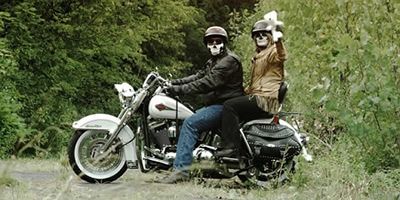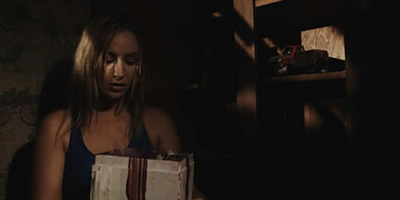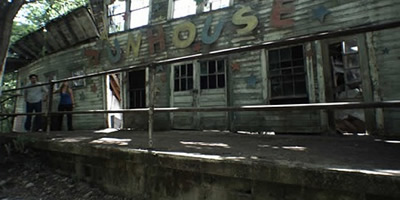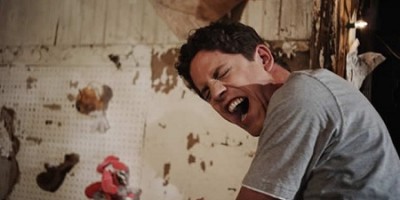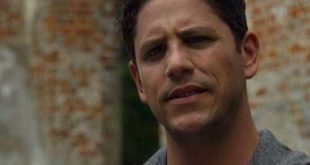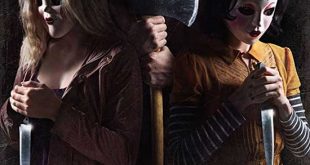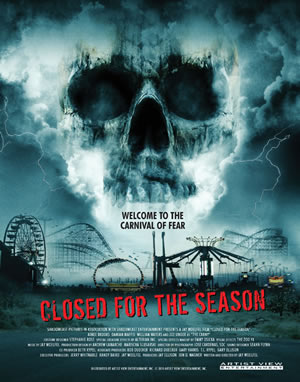
SYNOPSIS:
Set almost entirely within an an abandoned amusement park in Chippewa Lake, Ohio, Closed for the Season has a young woman (Kristy – Aimme Brooks) awaken to find herself trapped in the park grounds. Confused, disoriented and afraid, she encounters a terrifying carnival barker (Joe Unger) who bombards her with visions of death and terror from both the past and the future. She soon finds she is not alone when she encounters James (Damian Maffei) who is also trapped within the park and a previous victim, Dyrk (Will Waters) now confined to a wheelchair, circling the grounds. Kristy and James repeatedly avoid and survive the monsters, demons and ghosts that haunt the amusement park while trying to solve the mysteries that just may set them free.
REVIEW:
Jay Woelfel’s schizophrenic horror film, Closed for the Season, is a confusing mess that gets lost in its own ambitious script. The story is overcomplicated and unclear in its execution, never presenting a narrative that makes sense, even after the conclusion attempts to ties all the events together. Some of the ideas are clever and inventive but the elements that wrap them together are neither bizarre enough nor engaging enough to draw the viewer in. The actors do their best to make their characters interesting even though their relationships are circumstantial and inconsequential. The conclusion simultaneously brings purpose to these characters and undermines their motivations resulting in unrewarding character arcs and a weak ending. Joe Unger steps in every few minutes or so to liven things up as the spectral carny providing a slew of fun, amusing and creepy appearances while performing a variety of grisly acts.
Aimme Brooks and Damian Maffei provide Closed for the Season with attractive and charming leads. Their characters also share a natural chemistry between them that makes their instant relationship come across naturally regardless of how coincidental and forced they are thrown together. They keep their characters grounded and serious even as the events surrounding them become more and more preposterous. This helps the film greatly, allowing the audience to keep interested in the more confusing story beats. When things get silly, they never do – they always play it straight. Joe Unger, playing the carny, gets to do more outrageous and oddball acts in the film, whether it be wearing a bizarre array of clown and carnival costumes to spouting out whimsical, over-wrought dialog. He seems to be having fun playing the character which keeps the carny lively, entertaining and unpredictable. As enjoyable as the performance is, it occasionally feels forced and too blatant even for a boisterous carny. He gets the opportunity to play a different character toward the finale that displays a different side to his acting that works on that level quite well.
Closed for the Season’s biggest asset is its location, an actual abandoned amusement park, dilapidated and almost totally overgrown with vegetation and decay. It sets the mood effectively and brings an authenticity that built sets would have difficulty achieving. Jay Woelfel makes the most of his live sets. The characters often feel in actual jeopardy, if not from the carny, from either the decrepit structures or the elements themselves. The filmmakers make use of a rundown rollercoaster, a collapsed funhouse, a broken ferris wheel and a junked automobile. Most audience members are familiar with these visuals and their ramshackled appearance immediately embodies the story with a dangerous, mysterious tone. It also helps make the silly carny costumes appear menacing and helps the accompanying monsters, ghosts and other creatures garner menace they otherwise would not have acquired. The only times the sets fail are when they have to become active or functional: when a ghostly coaster must zoom along the tracks or when the overgrowth obscures the location too much.
The biggest challenge for the film is its convoluted story. The plot has a great deal of trouble conveying its themes within its dreamlike execution. It’s never clear if the characters are actually experiences what is being displayed or it ever puts them in real danger. Kristy and James are frequently shown getting dismembered, attacked or even killed only to appear in the next scene back to “normal.” While the characters remain aware of these events, for the audience, it undermines all the tension for the following scenes. If there are no consequences for the danger encountered in the following set pieces then interest and involvement suffers. On top of that it is rarely clear on what is actually happening anyway or what it means. Most of these questions are wrapped up in the conclusion, but by that time, it’s almost too late.
Closed for the Season has its share of inventive and clever ideas and twists but falters in their execution, creating a confusing, stumbling story that has difficulty maintaining interest. Even with a pair of compelling lead characters and an goofy but amusing villainous carny, the film has trouble capitalizing on the sensational locations that populate the vignettes. Goofy, unconvincing special effects and silly – even if oddly appropriate – creature costumes mar the film further. For an independent feature, the film has a commendable quality and cinematography and it keeps things fast paced with its segmented set pieces. Closed for the Season is not a total disaster, the ideas are sound and the acting is solid, it just gets overwhelmed in its own ambition. For many, it may not be worth a visit, while for others it may marginally provide an entertaining few hours.
2 out of 5
Closed for the Season (2010)
 Horror News | HNN Official Site | Horror Movies,Trailers, Reviews
Horror News | HNN Official Site | Horror Movies,Trailers, Reviews
